高中英语倒装句讲解
- 格式:ppt
- 大小:1.82 MB
- 文档页数:31
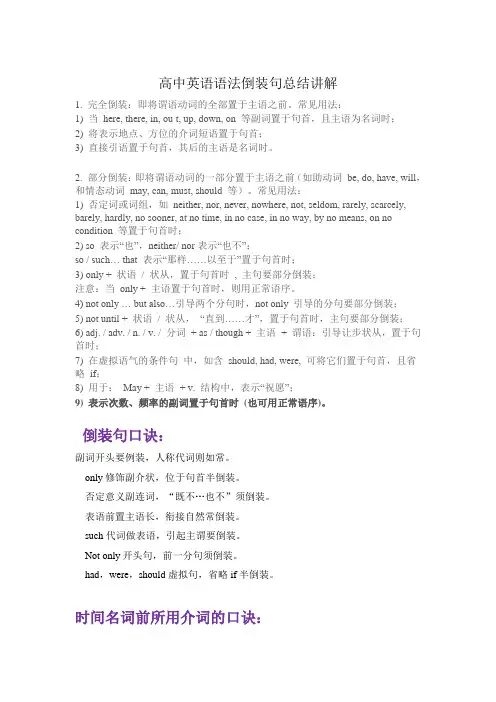
高中英语语法倒装句总结讲解1. 完全倒装:即将谓语动词的全部置于主语之前。
常见用法:1) 当here, there, in, ou t, up, down, on 等副词置于句首,且主语为名词时;2) 将表示地点、方位的介词短语置于句首;3) 直接引语置于句首,其后的主语是名词时。
2. 部分倒装:即将谓语动词的一部分置于主语之前(如助动词be, do, have, will,和情态动词may, can, must, should 等)。
常见用法:1) 否定词或词组,如neither, nor, never, nowhere, not, seldom, rarely, scarcely, barely, hardly, no sooner, at no time, in no case, in no way, by no means, on no condition 等置于句首时;2) so 表示“也”,neither/ nor表示“也不”;so / such… that 表示“那样……以至于”置于句首时;3) only + 状语/ 状从,置于句首时, 主句要部分倒装;注意:当only + 主语置于句首时,则用正常语序。
4) not only … but also…引导两个分句时,not only 引导的分句要部分倒装;5) not until + 状语/ 状从,“直到……才”,置于句首时,主句要部分倒装;6) adj. / adv. / n. / v. / 分词+ as / though + 主语+ 谓语:引导让步状从,置于句首时;7) 在虚拟语气的条件句中,如含should, had, were, 可将它们置于句首,且省略if;8) 用于:May + 主语+ v. 结构中,表示“祝愿”;9) 表示次数、频率的副词置于句首时(也可用正常语序)。
倒装句口诀:副词开头要例装,人称代词则如常。
only修饰副介状,位于句首半倒装。
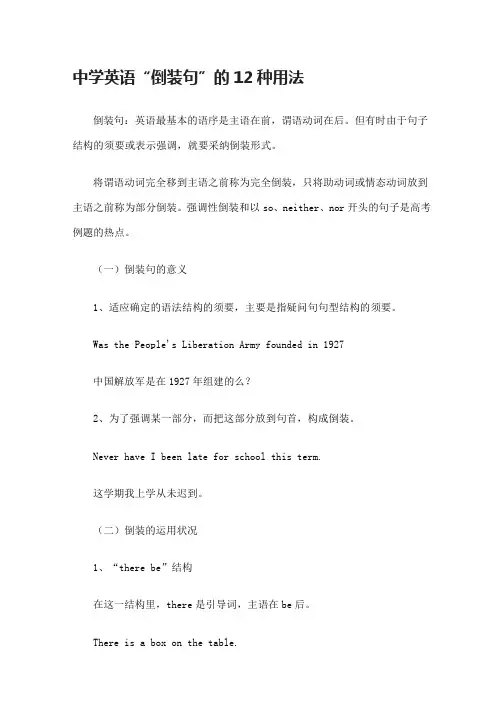
中学英语“倒装句”的12种用法倒装句:英语最基本的语序是主语在前,谓语动词在后。
但有时由于句子结构的须要或表示强调,就要采纳倒装形式。
将谓语动词完全移到主语之前称为完全倒装,只将助动词或情态动词放到主语之前称为部分倒装。
强调性倒装和以so、neither、nor开头的句子是高考例题的热点。
(一)倒装句的意义1、适应确定的语法结构的须要,主要是指疑问句句型结构的须要。
Was the People's Liberation Army founded in 1927中国解放军是在1927年组建的么?2、为了强调某一部分,而把这部分放到句首,构成倒装。
Never have I been late for school this term.这学期我上学从未迟到。
(二)倒装的运用状况1、“there be”结构在这一结构里,there是引导词,主语在be后。
There is a box on the table.桌子上有个盒子。
2、疑问句疑问句为倒装形式。
Is she singing in the classroom她是不是正在教室里唱歌?3、here、there等副词开头的句子(部分)在here、there等副词开头的某些句子中(要用一般现在时态)(前两个例句);假如主语是人称代词,主语和主要动词的词序不变。
(完全倒装)(最终一个例句)There goes the bell.铃响了。
Here is an apple for you.这个苹果给你。
There she comes.她来了。
4、重复倒装句型在以so、nor、neither开头,表示谓语所述的状况也适用于另一个人或一事物的确定或否定句中。
so用于确定句,表示“也一样”、“也这样”;nor、neither用于否定句,表示“同样也不,也不这样”。
I am watching TV. So is she.我在看电视,她也是。
My parents didn't watch TV last night. Neither (Nor) did I.我父母昨晚没有看电视,我也没看。
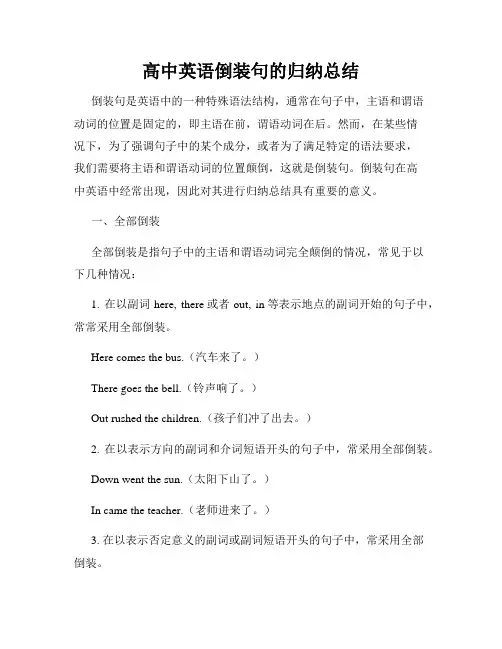
高中英语倒装句的归纳总结倒装句是英语中的一种特殊语法结构,通常在句子中,主语和谓语动词的位置是固定的,即主语在前,谓语动词在后。
然而,在某些情况下,为了强调句子中的某个成分,或者为了满足特定的语法要求,我们需要将主语和谓语动词的位置颠倒,这就是倒装句。
倒装句在高中英语中经常出现,因此对其进行归纳总结具有重要的意义。
一、全部倒装全部倒装是指句子中的主语和谓语动词完全颠倒的情况,常见于以下几种情况:1. 在以副词here, there或者out, in等表示地点的副词开始的句子中,常常采用全部倒装。
Here comes the bus.(汽车来了。
)There goes the bell.(铃声响了。
)Out rushed the children.(孩子们冲了出去。
)2. 在以表示方向的副词和介词短语开头的句子中,常采用全部倒装。
Down went the sun.(太阳下山了。
)In came the teacher.(老师进来了。
)3. 在以表示否定意义的副词或副词短语开头的句子中,常采用全部倒装。
Never have I seen such a beautiful view.(我从未见过如此美景。
)Not only does he play basketball, but he also plays football.(他不仅打篮球,还踢足球。
)二、部分倒装部分倒装是指只将谓语动词和助动词或情态动词提到主语之前,而将其他成分保持原来顺序的情况。
常见的部分倒装有以下几种情况:1. 在以表示否定意义的副词或副词短语位于句首时,动词与主语之间采用部分倒装。
Never have I been to Paris.(我从未去过巴黎。
)Hardly had she finished her speech when they clapped.(她刚刚讲完演讲就被他们鼓掌了。
)2. 在以so和neither引导的倒装句中,动词与主语之间采用部分倒装。
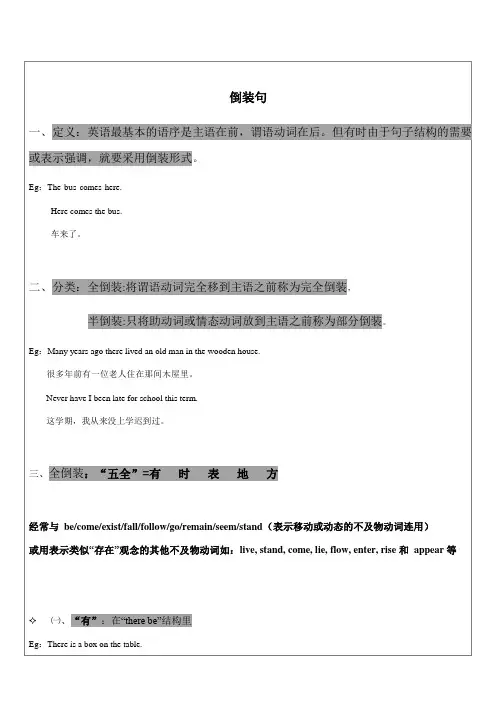
桌子上面有一个盒子。
✧㈡、“时”:表示时间副词,如:now,then,
Eg:Now comes your turn.
现在轮到你了。
✧㈢、“表”:表语放句子前,“表语+系动词+主语” 的结构
Eg:Present at the party were Mr. Green and many other guests.
格林先生和其他的客人在这个聚会上。
Seated on the ground are a group of young men.
一群年轻人坐在了地上。
✧㈣、“地”:地点状语放在句首
Eg:In south of the river lies a small factory.
小工厂位于河的南方。
From the valley came a cry.
山谷传来一阵哭声。
✧㈤、“方”:表方位的副词here, there 或out, in, up, down, away, off 等标志词放在句首 Eg:There lies a large wheat field in front of the house.
房子前面有一大片麦田。
Off all the lights went when I came in.
当我进来时,所有的灯都灭了。
四、半倒装:“八部”=不只让步也常需(虚)如此祝福✧㈠、“不”表示否定。
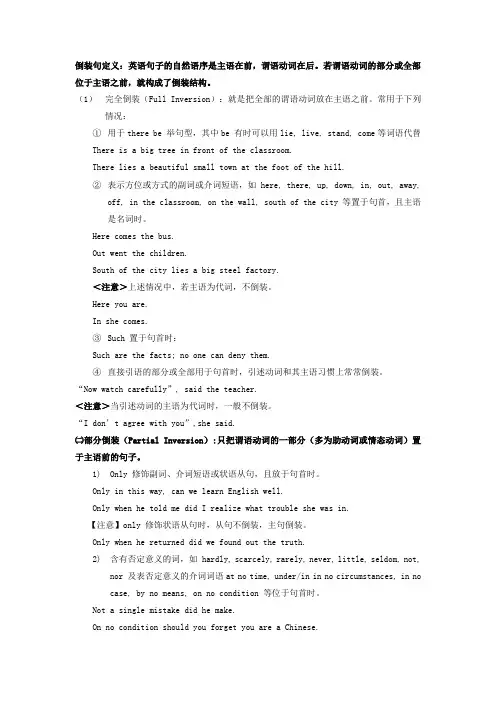
倒装句定义:英语句子的自然语序是主语在前,谓语动词在后。
若谓语动词的部分或全部位于主语之前,就构成了倒装结构。
(1)完全倒装(Full Inversion):就是把全部的谓语动词放在主语之前。
常用于下列情况:①用于there be 举句型,其中be 有时可以用lie, live, stand, come等词语代替There is a big tree in front of the classroom.There lies a beautiful small town at the foot of the hill.②表示方位或方式的副词或介词短语,如 here, there, up, down, in, out, away,off, in the classroom, on the wall, south of the city 等置于句首,且主语是名词时。
Here comes the bus.Out went the children.South of the city lies a big steel factory.<注意>上述情况中,若主语为代词,不倒装。
Here you are.In she comes.③Such 置于句首时:Such are the facts; no one can deny them.④直接引语的部分或全部用于句首时,引述动词和其主语习惯上常常倒装。
“N ow watch carefully”, said the teacher.<注意>当引述动词的主语为代词时,一般不倒装。
“I don’t agree with you”,she said.㈡部分倒装(Partial Inversion):只把谓语动词的一部分(多为助动词或情态动词)置于主语前的句子。
1)Only 修饰副词、介词短语或状语从句,且放于句首时。
Only in this way, can we learn English well.Only when he told me did I realize what trouble she was in.【注意】only 修饰状语从句时,从句不倒装,主句倒装。
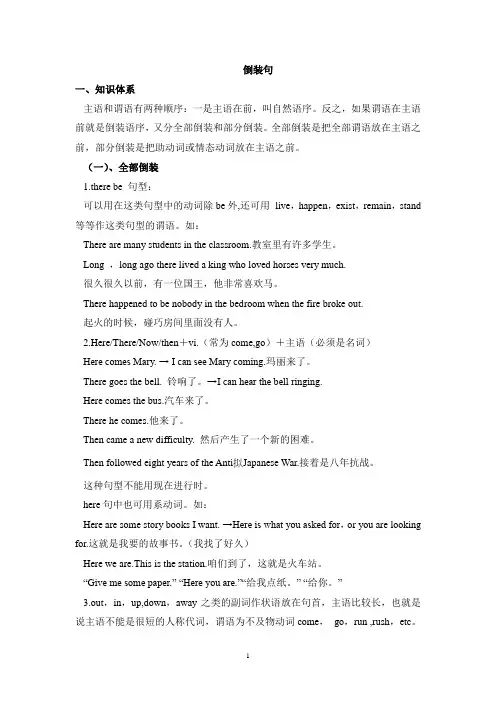
倒装句一、知识体系主语和谓语有两种顺序:一是主语在前,叫自然语序。
反之,如果谓语在主语前就是倒装语序,又分全部倒装和部分倒装。
全部倒装是把全部谓语放在主语之前,部分倒装是把助动词或情态动词放在主语之前。
(一)、全部倒装1.there be 句型:可以用在这类句型中的动词除be外,还可用live,happen,exist,remain,stand 等等作这类句型的谓语。
如:There are many students in the classroom.教室里有许多学生。
Long ,long ago there lived a king who loved horses very much.很久很久以前,有一位国王,他非常喜欢马。
There happened to be nobody in the bedroom when the fire broke out.起火的时候,碰巧房间里面没有人。
2.Here/There/Now/then+vi.(常为come,go)+主语(必须是名词)Here comes Mary. → I can see Mary coming.玛丽来了。
There goes the bell. 铃响了。
→I can hear the bell ringing.Here comes the bus.汽车来了。
There he comes.他来了。
Then came a new difficulty. 然后产生了一个新的困难。
Then followed eight years of the Anti Japanese War.接着是八年抗战。
这种句型不能用现在进行时。
here句中也可用系动词。
如:Here are some story books I wa nt. →Here is what you asked for,or you are looking for.这就是我要的故事书。
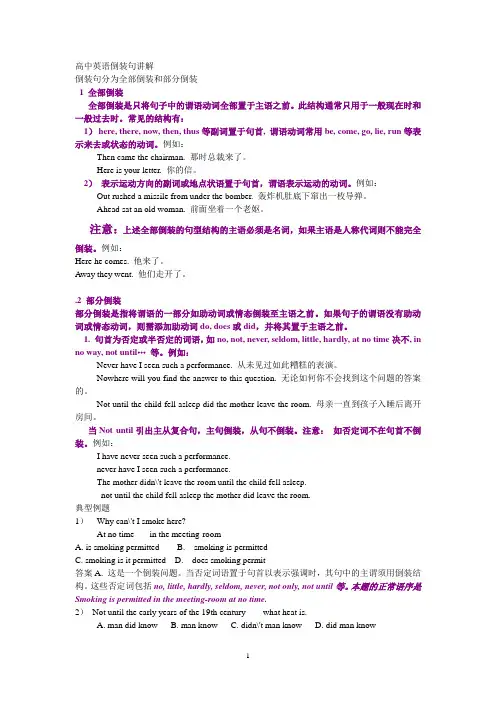
高中英语倒装句讲解倒装句分为全部倒装和部分倒装1 全部倒装全部倒装是只将句子中的谓语动词全部置于主语之前。
此结构通常只用于一般现在时和一般过去时。
常见的结构有:1)here, there, now, then, thus等副词置于句首, 谓语动词常用be, come, go, lie, run等表示来去或状态的动词。
例如:Then came the chairman. 那时总裁来了。
Here is your letter. 你的信。
2)表示运动方向的副词或地点状语置于句首,谓语表示运动的动词。
例如:Out rushed a missile from under the bomber. 轰炸机肚底下窜出一枚导弹。
Ahead sat an old woman. 前面坐着一个老妪。
注意:上述全部倒装的句型结构的主语必须是名词,如果主语是人称代词则不能完全倒装。
例如:Here he comes. 他来了。
Away they went. 他们走开了。
.2 部分倒装部分倒装是指将谓语的一部分如助动词或情态倒装至主语之前。
如果句子的谓语没有助动词或情态动词,则需添加助动词do, does或did,并将其置于主语之前。
1. 句首为否定或半否定的词语,如no, not, never, seldom, little, hardly, at no time决不, in no way, not until…等。
例如:Never have I seen such a performance. 从未见过如此糟糕的表演。
Nowhere will you find the answer to this question. 无论如何你不会找到这个问题的答案的。
Not until the child fell asleep did the mother leave the room. 母亲一直到孩子入睡后离开房间。
当Not until引出主从复合句,主句倒装,从句不倒装。
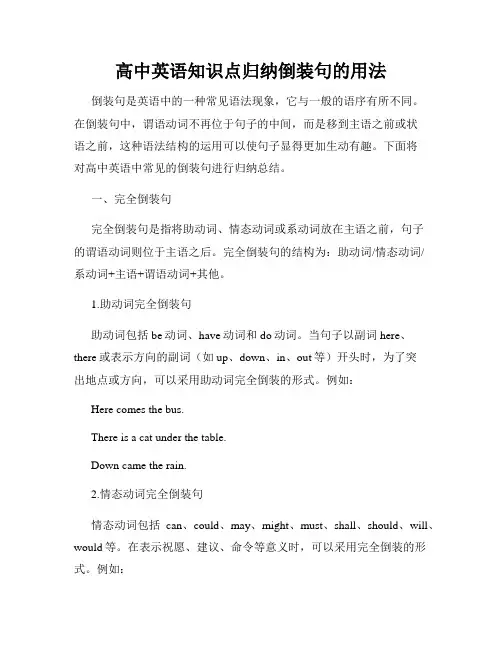
高中英语知识点归纳倒装句的用法倒装句是英语中的一种常见语法现象,它与一般的语序有所不同。
在倒装句中,谓语动词不再位于句子的中间,而是移到主语之前或状语之前,这种语法结构的运用可以使句子显得更加生动有趣。
下面将对高中英语中常见的倒装句进行归纳总结。
一、完全倒装句完全倒装句是指将助动词、情态动词或系动词放在主语之前,句子的谓语动词则位于主语之后。
完全倒装句的结构为:助动词/情态动词/系动词+主语+谓语动词+其他。
1.助动词完全倒装句助动词包括be动词、have动词和do动词。
当句子以副词here、there或表示方向的副词(如up、down、in、out等)开头时,为了突出地点或方向,可以采用助动词完全倒装的形式。
例如:Here comes the bus.There is a cat under the table.Down came the rain.2.情态动词完全倒装句情态动词包括can、could、may、might、must、shall、should、will、would等。
在表示祝愿、建议、命令等意义时,可以采用完全倒装的形式。
例如:May you have a happy birthday!Should you need any help, feel free to ask.Will you please close the door?3.系动词完全倒装句系动词包括be动词、seem、appear、look、sound等。
在表示位置、方式、状态、主语特征等方面时,可以采用系动词完全倒装的形式。
例如:On the table lies a book.How beautiful the flowers are!Tired as he was, he kept working.二、部分倒装句部分倒装句是指将谓语动词的一部分(通常是助动词或情态动词)与主语之间的位置对调,这种语法结构常见于否定句、选择疑问句和以感叹词开头的句子。
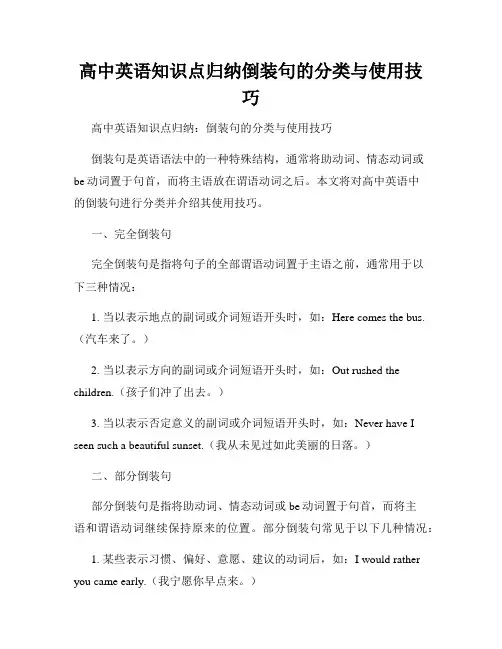
高中英语知识点归纳倒装句的分类与使用技巧高中英语知识点归纳:倒装句的分类与使用技巧倒装句是英语语法中的一种特殊结构,通常将助动词、情态动词或be动词置于句首,而将主语放在谓语动词之后。
本文将对高中英语中的倒装句进行分类并介绍其使用技巧。
一、完全倒装句完全倒装句是指将句子的全部谓语动词置于主语之前,通常用于以下三种情况:1. 当以表示地点的副词或介词短语开头时,如:Here comes the bus.(汽车来了。
)2. 当以表示方向的副词或介词短语开头时,如:Out rushed the children.(孩子们冲了出去。
)3. 当以表示否定意义的副词或介词短语开头时,如:Never have I seen such a beautiful sunset.(我从未见过如此美丽的日落。
)二、部分倒装句部分倒装句是指将助动词、情态动词或be动词置于句首,而将主语和谓语动词继续保持原来的位置。
部分倒装句常见于以下几种情况:1. 某些表示习惯、偏好、意愿、建议的动词后,如:I would rather you came early.(我宁愿你早点来。
)2. 在表语从句中,如:What she needs is not money, but love.(她需要的不是金钱,而是爱。
)3. 在条件状语从句或时间状语从句中,如:Should you have any questions, feel free to ask.(如果你有任何问题,请随时提问。
)4. 在虚拟条件句中,如:Had I known earlier, I would have helped.(要是我早知道,我会帮忙的。
)三、倒装句的使用技巧1. 在虚拟语气中,常用部分倒装句来表达与事实相反的假设,如:Were it not for your help, I would have failed.(要不是你的帮助,我就会失败。
)2. 当表示时间或地点的副词放于句首时,采用完全倒装句,如:In front of me stood a majestic mountain.(在我面前矗立着一座雄伟的山峰。
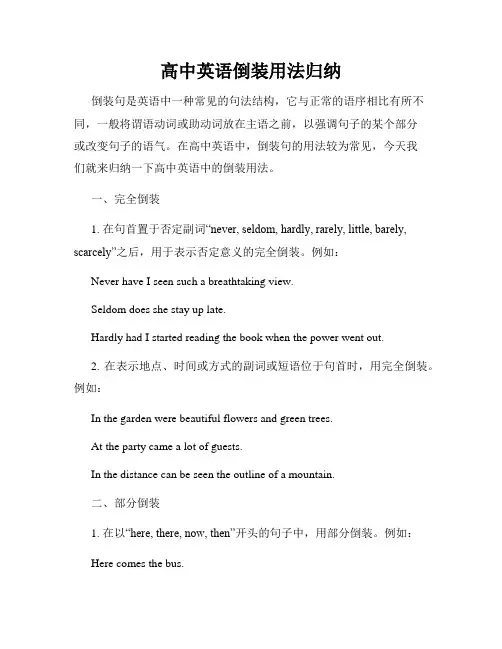
高中英语倒装用法归纳倒装句是英语中一种常见的句法结构,它与正常的语序相比有所不同,一般将谓语动词或助动词放在主语之前,以强调句子的某个部分或改变句子的语气。
在高中英语中,倒装句的用法较为常见,今天我们就来归纳一下高中英语中的倒装用法。
一、完全倒装1. 在句首置于否定副词“never, seldom, hardly, rarely, little, barely, scarcely”之后,用于表示否定意义的完全倒装。
例如:Never have I seen such a breathtaking view.Seldom does she stay up late.Hardly had I started reading the book when the power went out.2. 在表示地点、时间或方式的副词或短语位于句首时,用完全倒装。
例如:In the garden were beautiful flowers and green trees.At the party came a lot of guests.In the distance can be seen the outline of a mountain.二、部分倒装1. 在以“here, there, now, then”开头的句子中,用部分倒装。
例如:Here comes the bus.There goes the bell.Now is the time for action.Then came the news that we had won.2. 当表示“only, so, nor, neither”等否定意义的词语位于句首时,用部分倒装。
例如:Only in this way can we achieve success.So angry was he that he couldn't speak.Nor did I see any familiar faces in the crowd.Neither have I read the book.3. 当以“never, seldom, rarely”等词作为修饰性状语位于句首时,也可用部分倒装。
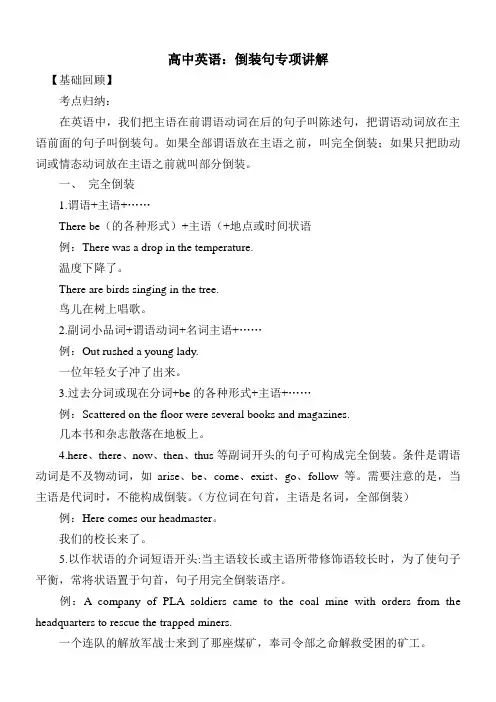
高中英语:倒装句专项讲解【基础回顾】考点归纳:在英语中,我们把主语在前谓语动词在后的句子叫陈述句,把谓语动词放在主语前面的句子叫倒装句。
如果全部谓语放在主语之前,叫完全倒装;如果只把助动词或情态动词放在主语之前就叫部分倒装。
一、完全倒装1.谓语+主语+……There be(的各种形式)+主语(+地点或时间状语例:There was a drop in the temperature.温度下降了。
There are birds singing in the tree.鸟儿在树上唱歌。
2.副词小品词+谓语动词+名词主语+……例:Out rushed a young lady.一位年轻女子冲了出来。
3.过去分词或现在分词+be的各种形式+主语+……例:Scattered on the floor were several books and magazines.几本书和杂志散落在地板上。
4.here、there、now、then、thus等副词开头的句子可构成完全倒装。
条件是谓语动词是不及物动词,如arise、be、come、exist、go、follow等。
需要注意的是,当主语是代词时,不能构成倒装。
(方位词在句首,主语是名词,全部倒装)例:Here comes our headmaster。
我们的校长来了。
5.以作状语的介词短语开头:当主语较长或主语所带修饰语较长时,为了使句子平衡,常将状语置于句首,句子用完全倒装语序。
例:A company of PLA soldiers came to the coal mine with orders from the headquarters to rescue the trapped miners.一个连队的解放军战士来到了那座煤矿,奉司令部之命解救受困的矿工。
二、部分倒装1.only +状语或状语从句置于句首,被该状语修饰的句子用部分倒装。
例:Only in this way can you solve this problem.只有用这种方法,你才可以解决这个问题。
高中英语倒装句讲解高中英语倒装句讲解一、什么是倒装句倒装句是英语中常用的一种语法结构,它通过改变句子中词语的正常顺序,使句子更加生动、形象。
在倒装句中,主语和宾语的位置常常颠倒,同时句子结尾的语态也不同于正常语序。
二、倒装句的种类1、完全倒装句:这种类型的倒装句把主语和宾语完全颠倒,让宾语出现在主语之前。
例如:“Here comes the bus”(公交车来了)。
2、部分倒装句:这种倒装句只把助动词、系动词或情态动词放在主语前面,其余部分仍保持正常语序。
例如:“Are you ready to leave?”(你准备好离开了吗?)三、如何使用倒装句1、为了让句子更加生动,可以使用倒装句。
例如,比起常规语序的“The book is on the table”,使用倒装句“On the table is the book”更能突出物体的位置。
2、在一些情况下,使用倒装句可以更好地表达对比、惊讶等感情色彩。
例如,“Out rushed the dog”比“The dog rushed out”更能表达出狗冲出来的急迫感。
3、在一些疑问句中,为了更好地表达疑问点,需要使用倒装句。
例如,“Did he go to school yesterday?”比“Did he go to school?”更加具体。
四、注意事项1、在使用倒装句时,要注意句子的逻辑性和连贯性,避免出现歧义或误解。
2、在写作中,要根据文章的整体风格和语境来选择使用倒装句,不要过度使用,以免影响阅读体验。
3、在学习倒装句时,要掌握不同类型的倒装句的语法规则,并通过大量的阅读和写作实践来提高自己的语感和应用能力。
总之,掌握英语倒装句对于提高英语表达能力和写作水平都非常重要。
通过深入理解倒装句的语法规则,正确运用倒装句,可以让我们的英语表达更加生动、丰富,更具有表现力和感染力。
高中英语倒装句讲解 Final approval draft on November 22, 2020倒装句讲解英语句子通常有两种语序:一种是陈述语序,一种是倒装语序。
将谓语的一部分或全部置于主语之前的语序叫做倒装语序。
倒装可分为二种:将整个谓语提到主语之前的叫完全倒装(full inversion);而只将be 、情态动词或者助动词放在主语之前的叫做部分倒装(partialinversion)。
形式倒装:只把强调的内容提至句首,主谓并不倒装形式倒装有四类:(1)感叹句:What + a/an + adj +n.+(主语+谓语)!How + adj /adv.+(主语+谓语)!(2)The+比较级+正常语序句子,The+比较级+正常语序句子。
“越……,越…….。
”(3)Whatever+n.+主语+谓语,主句。
However+ adj/adv+主语+谓语,主句。
(4)As/Although引导让步状语从句时,可以对表语、谓语、状语进行强调。
(注意:若对表语进行强调时,表语为单数可数名词,形容词最高级时,要省掉冠词)一、完全倒装1. There be结构。
另外,在此结构中可以用来代替be动词的动词有:exist, seem, happen, appear, live, rise, stand等。
如:There stood a dog before him.There exist different opinions on this question.巩固练习:1) ________ a beautiful palace ________ the foot of the hill.A. There stand; atB. There stands; underC. Stands there; underD. There stands; at2 (1).在以here、there、now、then等副词开头的句子里。
高中英语语法:特殊句式之倒装句一、全部倒装全部倒装就是把句子的谓语动词前置到主语前面构成的倒装句。
★1、表示方向、地点、位置移动或时间的副词,比如in、out、down、off、away、now、then、here、there等置于句首且主语是名词时,句子用全部倒装。
◇Here comes the bus. 公交车来了【但当主语是人称代词时,句子不倒装。
比如Here she comes.她来了】◇Now comes your turn. 现在轮到你了。
◇Up went the fireworks into the air.嗖的一声,焰火上了天。
★2、表示存在的there be句型,主语在be之后。
除了be外,还可使用lie,live,come,exist,sit,stand,remain等不及物动词。
◇ There are so many things to learn today.今天有很多东西要学。
◇There exists an ancient temple in this town,which attracts many visitors.这个镇上有一个古代庙宇,吸引着许多游客。
3、介词短语放在句首作状语,谓语动词是lie, stand , sit ,exist , stretch , come等或系动词be,主语是名词时。
◇At the foot of the mountain lies a clean stream.山脚下有一条清澈的小溪。
4、代词such放在句首,句子的谓语动词是be。
◇Such is what he wanted.这就是他想要的。
5、为了保持句子平衡,使上下文紧密街接,常将表语和状语放在句首,引起主语和谓语的倒装。
◇Gone are the days when we used foreign oil.我们用“洋油”的时代一去不复返了6、现在分词、过去分词、形容词、副词等有时可移到句首,来对动作或状态加以强调。
高三英语倒装句知识点倒装句是英语中的一种特殊语法结构,常见于状语、地点状语、时间状语等部分的倒装,它的使用可以使句子更加丰富多样,并起到强调的作用。
下面将介绍一些高三英语中常见的倒装句知识点。
一、完全倒装1. 当句子以否定词开头时,常出现完全倒装。
例子:Never have I seen such a beautiful sunset.解析:否定词"Never"位于句首,使得动词"have"与主语" I"发生倒装。
2. 当表示地点的短语或副词位于句首时,常出现完全倒装。
例子:In front of the house stood a tall tree.解析:地点短语"In front of the house"位于句首,使得动词"stood"与主语" a tall tree"发生倒装。
3. 当表示方向的副词放在句首时,常使用完全倒装。
例子:Down the street ran the little boy.解析:副词"Down"置于句首,使得动词"ran"与主语" the little boy"发生倒装。
二、部分倒装1. 当句子以表示否定的副词或短语开头时,常出现部分倒装。
例子:Not only did she pass the exam, but she also got the highest score.解析:否定副词"Not only"位于句首,使得助动词"did"与主语"she"发生倒装。
2. 当使用含有比较级的状语从句时,常出现部分倒装。
例子:The harder you work, the more progress you will make.解析:状语从句"the harder you work"中的主谓发生倒装。
高中英语语法倒装句讲解(总7页)-CAL-FENGHAI.-(YICAI)-Company One1-CAL-本页仅作为文档封面,使用请直接删除倒装句一、全部倒装全部倒装即把整个谓语部分放在主语之前。
当副词here, there, in, out, up, down, away, back, then, ahead, off, over等位于句首、谓语动词常为be, come, go, follow, run, rush, fly, fall等不及物动词,而且主语又是名词时,用完全倒装。
注意:此类倒装只限于一般现在时和一般过去式,不用进行时态并且若主语是代词时,不用倒装。
同学们可借助下面的图形速记用于完全倒装的词。
1.介词短语(地点状语)+不及物动词+主语Under the tree sits a beautiful girl.=A beautiful girl sits under the tree. 树下坐着一位漂亮的女孩。
South of the lake lies a big supermarket. 湖泊的南边是一个大超市。
20 miles east of our school lies a modern swimming pool. 我们学校向东20英里有一个现代化的游泳池。
On the floor were piles of old books, magazines and newspapers. 地板上是一堆堆旧的书报杂志。
2.表方向、地点的副词(here, there, up, down, away)+不及物动词+主语,构成的全部倒装句Hearing the dog barking fiercely, away fled the thief. 听到狗的狂叫声,小偷逃掉了。
Here comes the bus. 公交来了。
There goes the bell. 铃响了。
3.“主+系+表”结构如强调表语通常转化为“表+系+主”(表语通常为形容词、现在分词和过去分词)的全部倒装句。
高考语法倒装句型高考语法之倒装句型倒装句是高考英语语法中的一个重要知识点,考察的频率也较高。
掌握倒装句类型的不同以及正确运用,对于高考英语的顺利通过十分必要。
本文将以2500字的篇幅,详细介绍高考语法之倒装句型。
倒装句,简单来说就是将正常语序的主语和谓语动词的位置颠倒过来,或者是将助动词移至主语前面。
倒装句分为整体倒装句和部分倒装句两种类型。
下面将分别进行介绍。
一、整体倒装句整体倒装句在高考中出现的频率相对较低,主要有以下几种情况:1.句首状语使用完全倒装在句首使用一些副词或短语时,需要将主语和谓语动词进行完全颠倒。
例如:Never have I seen such a beautiful sunset before.(我从未见过如此美丽的日落。
)Not only did he finish his homework, but also he cleaned the room.(他不仅完成了作业,而且还打扫了房间。
)2.以“here, there, now”开头的句子以“here, there, now”开头的句子也属于整体倒装句。
例如:Here comes the bus.(汽车来了。
)There goes the siren.(警报器响了。
)Now comes the time to say goodbye.(现在是告别的时候了。
)二、部分倒装句部分倒装句的出现频率相对较高,主要有以下几种情况:1.以“否定词+动词”开头的句子当以否定词“not, never, rarely, seldom, hardly, barely, little, few”等开头时,需要将助动词或情态动词提前,与主语一起形成部分倒装句。
例如:Not until then did I realize how important time is.(直到那时我才意识到时间的重要性。
)Hardly had she left the room when the phone rang.(她刚离开房间电话就响了。